The 2023/24 Moroccan Botola Pro League is currently at the halfway point, and the competition is proving to be thoroughly entertaining. Reigning champions AS FAR are once again staking their claim to be champions of Morocco as they sit in first place. Raja Club Athletic (Raja Casablanca) are hot on their heels having amassed an equal points tally, finding themselves in second place based on goal difference at the halfway stage.
Meanwhile, 22-time champions Wydad AC find themselves down in fourth place, eight points behind the league leaders and out of the Champions League and Confederation Cup qualification places. At the opposite end of the table, IR Tanger and Youssoufia Berrechid occupy the relegation places, with the latter having conceded the most goals so far.
This analysis piece will take the form of a data analysis where we will dig into the statistics to analyse the most productive attacking players in the Botola Pro League this season. Using data, we will be able to compare and contrast the attacking output of the players whilst considering how they currently fit into their team’s tactics and what they bring to the attacking phase of play.
Goalscoring
The sample pool for this analysis consists of players who line up in what we woul d consider to be attacking positions and have played over 800 minutes of football this season.
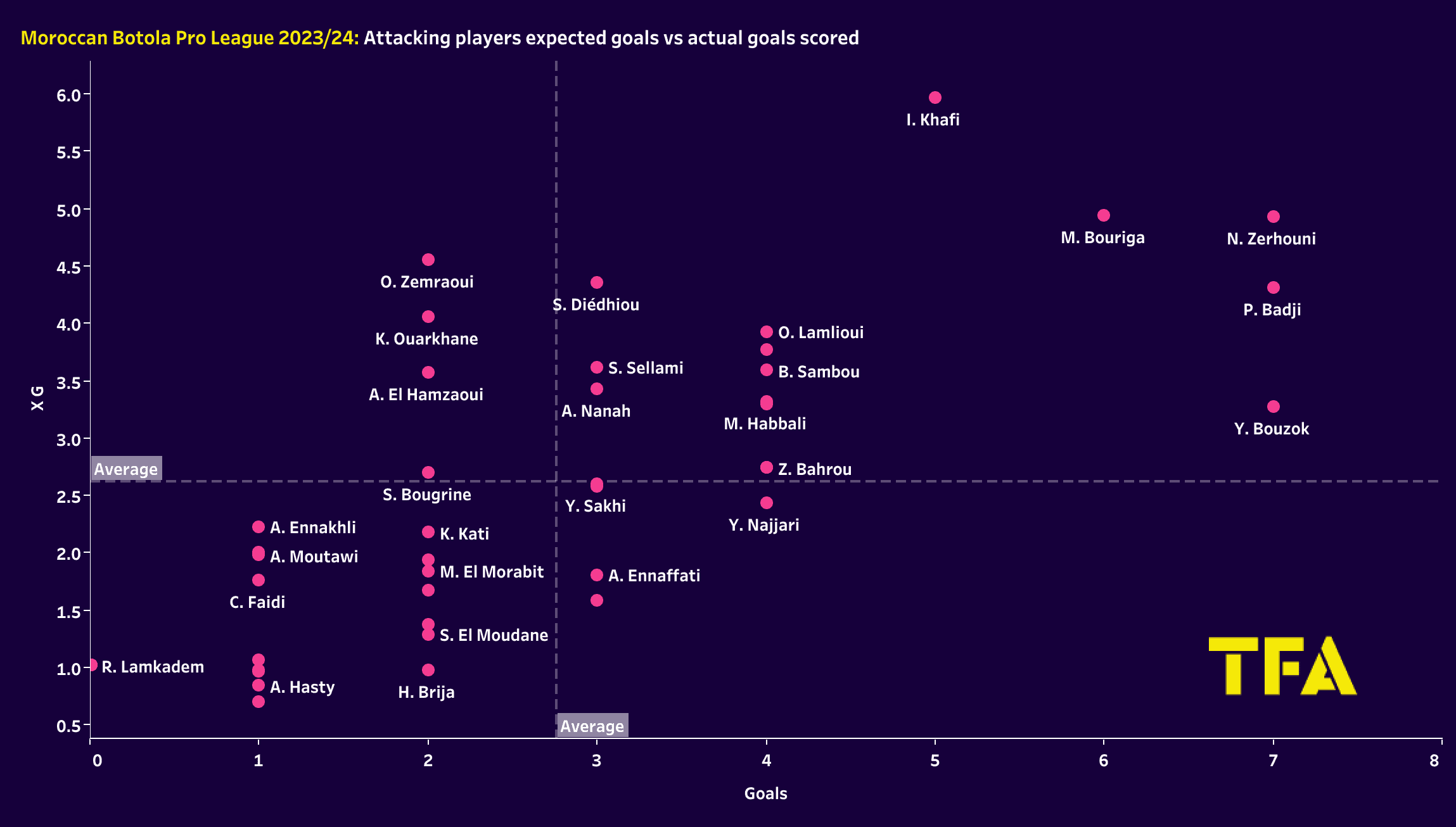
A good place to begin with this analysis is to look at how the players perform in terms of the number of goals scored compared to the number of expected goals. Naturally, our eyes are drawn to the players who are performing at an above-average rate.
The data visual tells us that Naoufel Zerhouni and Yousri Bouzok of Raja Casablanca lead the goalscoring charts with seven goals apiece. Alongside them is Pape Badji of MA Tétouan, and Mouchine Bouriga of MA Fés is just one behind on six goals so far.
Looking a little deeper, we can see that Zerhouni’s seven goals have come from an xG of 4.93, whilst Badji has netted seven times from an xG of 4.31. The best performer, though, is Bouzok, as he is quite significantly overperforming his xG of 3.27.
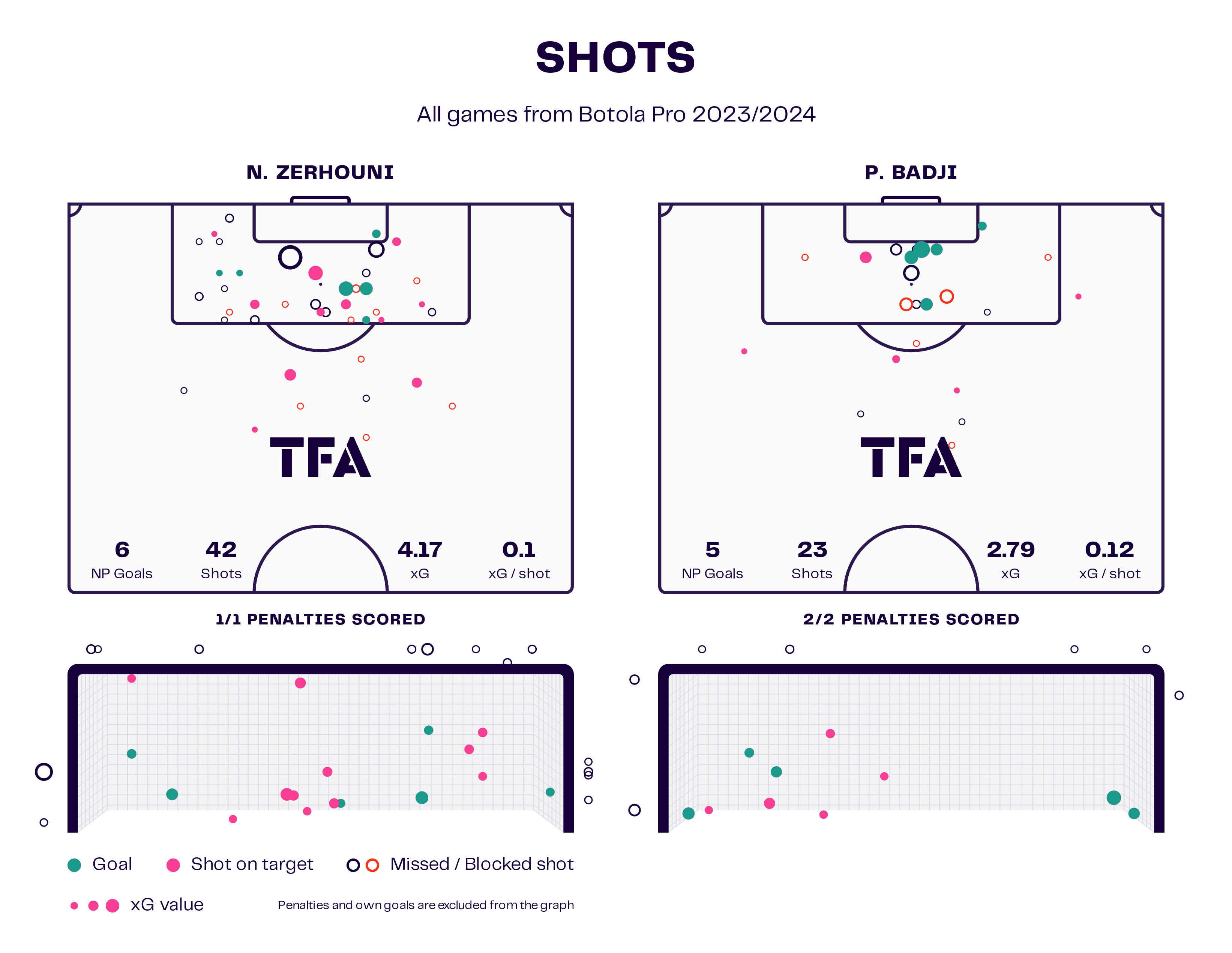
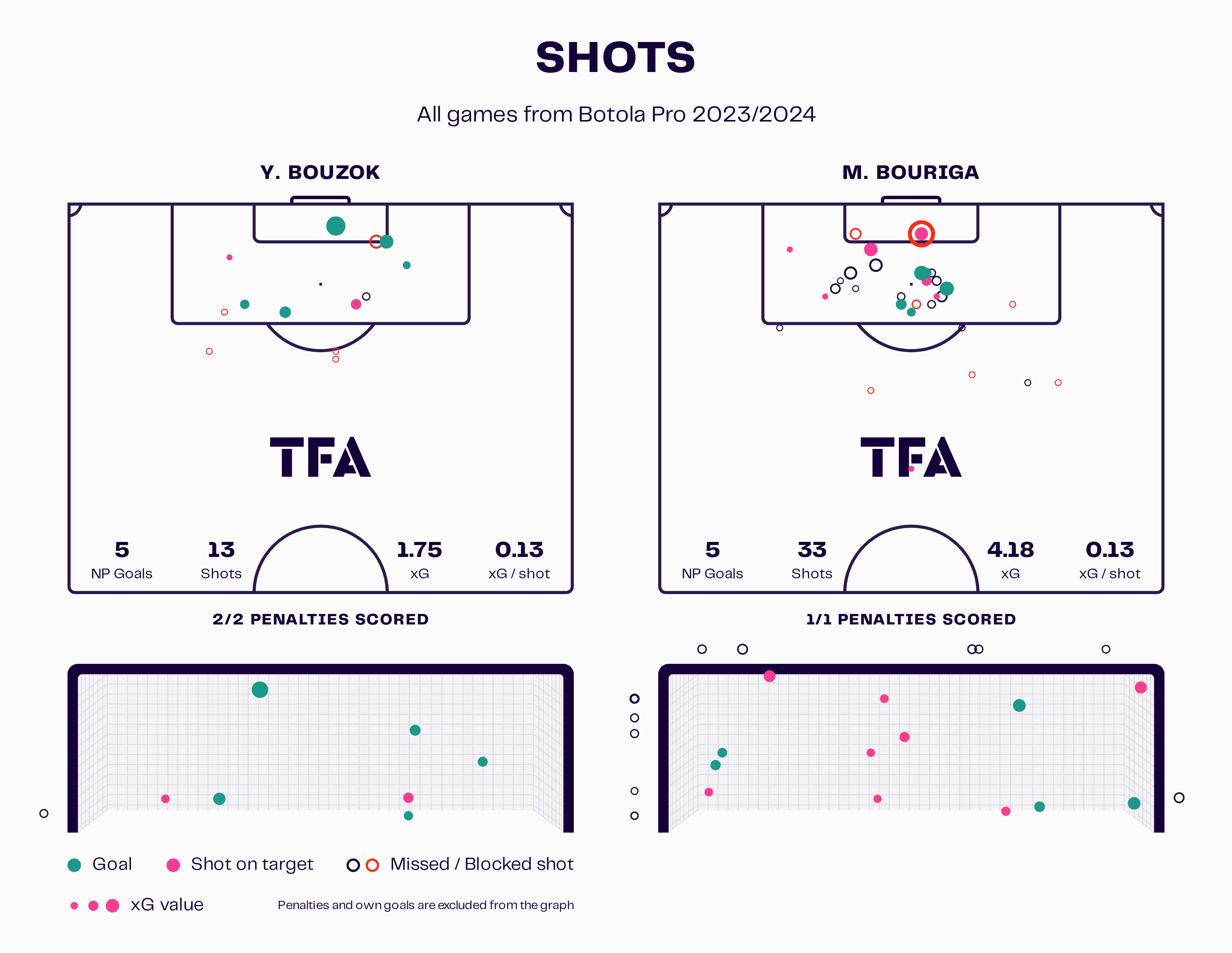
The data visuals above also allow us to see how many of those goals scored were non-penalty goals and the total number of shots taken by each player. We can see that Zerhouni has taken 42 shots so far this season, which has generated an NPxG of 4.17, suggesting he could be quite wasteful with his shooting as there are many missed and blocked shots in the visual. The 28-year-old typically plays as a centre forward in a 4-2-3-1 system, so he is the main focal point of the attack; therefore, it is also not unexpected that he would take a high number of shots.
Additionally, Bouzok has scoured five non-penalty goals from an NPxG of 1.75, indicating he is capable of scoring lower percentage chances. Bouzok primarily plays as a winger; he can play on either side but is particularly effective as an out-and-out winger on the right.
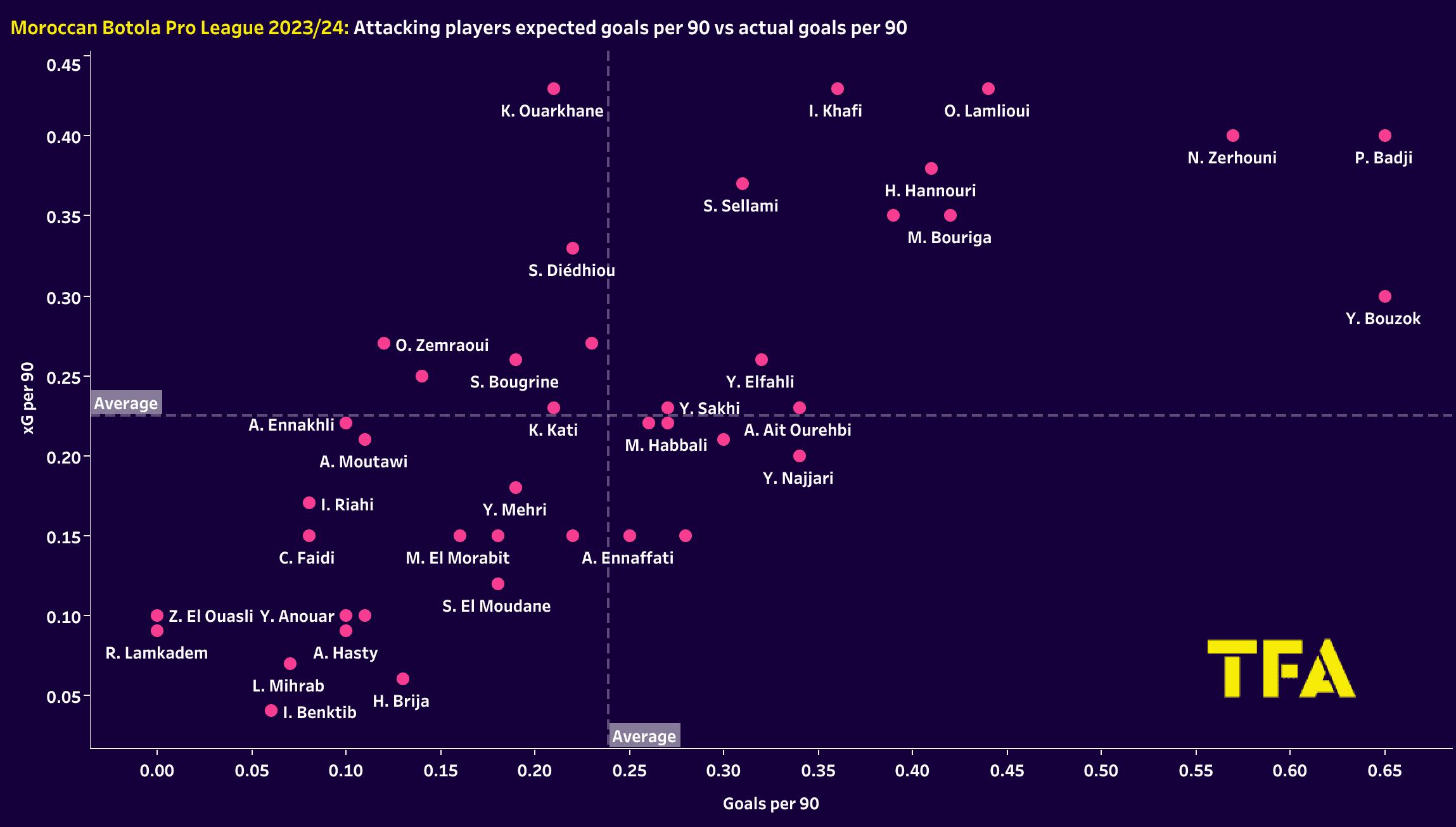
This data visual shows us how the data translates to xG per 90 and goals per 90. We can see that Zerhouni averages 0.57 goals per 90 from an xG per 90 of 0.40. Bouzok averages 0.65 goals per 90 from an xG per 90 of 0.30. Whilst Badji also averages 0.65 goals per 90, his xG per 90 is 0.40. Additionally, Oussama Lamlioui averages 0.44 goals per 90 from an xG per 90 of 0.43.
Rather than relying solely on total goals, which might be influenced by a few standout performances, for example, both Zerhouni and Bouzok scored hattricks in Raja Casablancas’s 6-1 victory over IR Tanger. Per 90, data provides a more stable measure of a player’s scoring efficiency.
Furthermore, this allows us to assess goal-scoring efficiency without being skewed by differences in total playing time. Players who consistently perform well in shorter periods are highlighted, offering a more accurate measure of their impact.
Oussama Lamlioui has played 824 minutes so far this season, which places him at the lower end of our sample group in terms of playing time. However, as we can see from the data visual, he is very effective with an above-average goal output based on his statistics per 90.
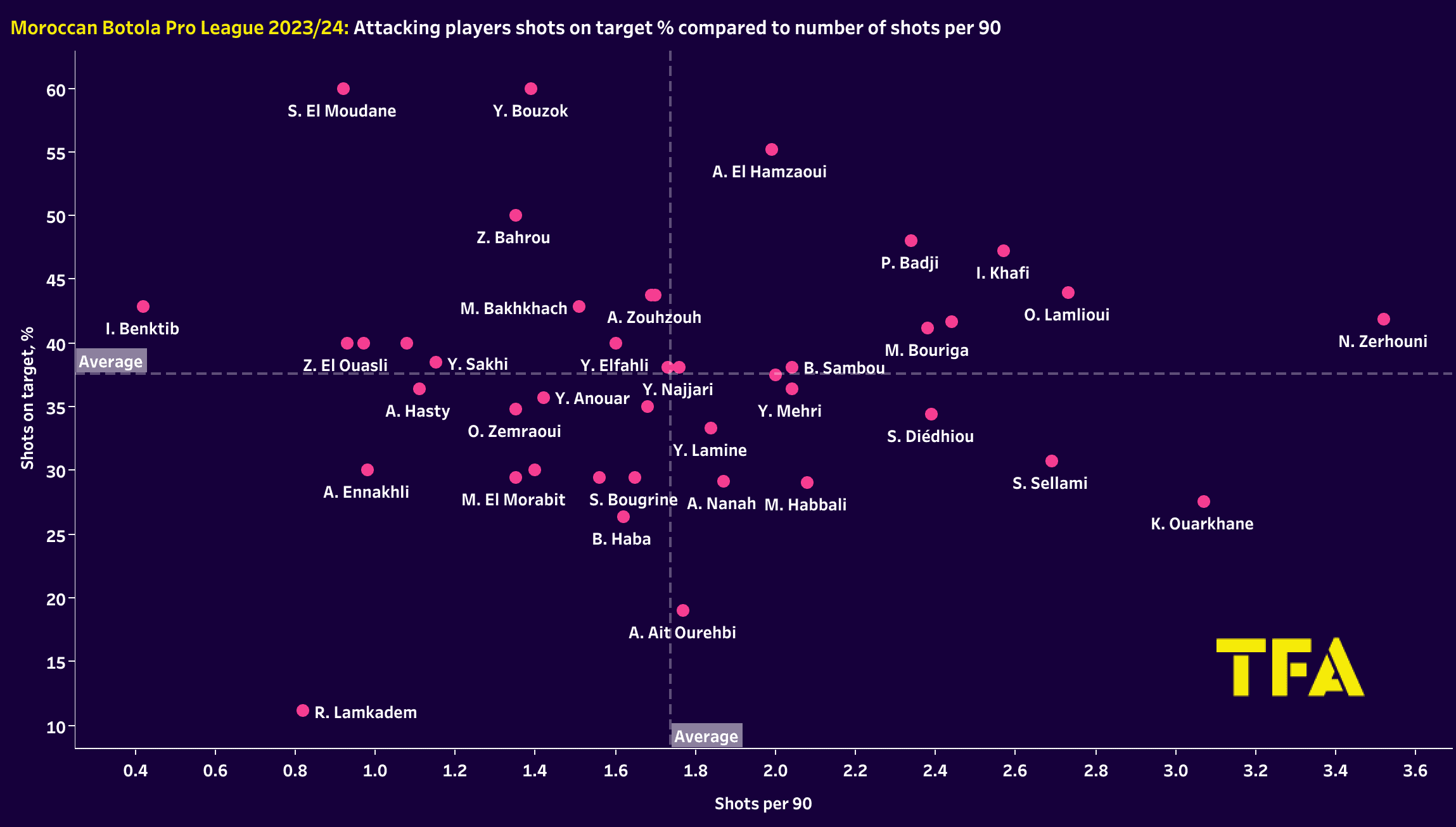
As we expect, Zerhouni takes the most shots per 90 of our sample group. The Raja Casablanca forward averages 3.52 shots per 90, with 41.86% of his overall shots being on target. Interestingly, Sofian El Moudane averages 0.92 shots per 90 but has the highest accuracy rating of 60%.
This indicates that he is not overly wasteful with his shooting and can hit the target quite often, implying he takes a strategic approach to shot selection. Rather than taking speculative or low-quality shots, the Hassania Agadir man prioritises high-quality opportunities. However, as he has only hit the back of the net twice this season, the few shots that El Moudane does hit are often saved by the opposition’s keeper.
Chance creation
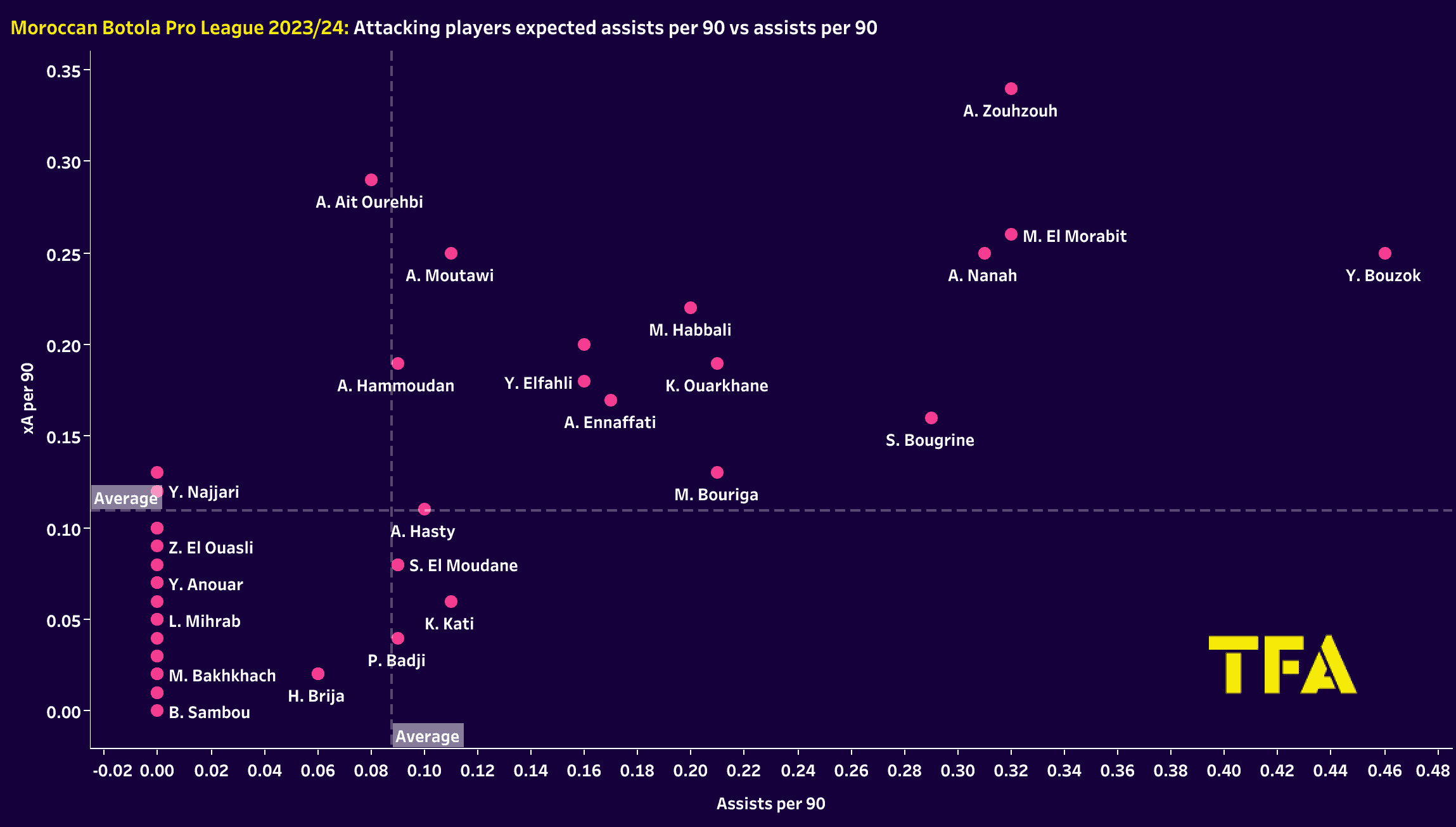
Now, in this section of the analysis, we will turn our attention to chance creation. Yousri Bouzok, once again, is a standout player as he averages 0.46 assists per 90 from an xA per 90 rating of 0.25. This suggests he is a creative force within his team. So far this season, he has racked up five assists in 13 appearances.
Given that his role in the team sees him play as a winger, his creativity is vital to Raja Casablancas’s 4-2-3-1 system. From this, we can infer that Bouzok has good vision and decision-making on the field as he can identify and execute passes that have a higher likelihood of resulting in assists than what statistical models predict. He is able to understand the positioning of teammates and opponents, and deliver precise passes due to a high level of footballing intelligence.
Moreover, Mohamed El Morabit of RSB Berkane is another standout player, averaging 0.32 assists per 90 from an xA per 90 rating of 0.26. He typically plays as a central attacking midfielder in a 4-2-3-1 system, which suggests he acts as a playmaker and links up well with the forward and wide players.
Additionally, Bouzok is not the only creative force among Raja Casablanca’s team, as Sabir Bougrine is performing above average in this metric. Like the aforementioned El Morabit, the 27-year-old is a central attacking midfielder. Bougrine currently averages 0.29 assists per 90 from an expected assist rate of 0.16 per 90.
We have to also consider that these stats are influenced by the goalscorers within the teams. For example, fellow attacking players may be scoring lower percentage opportunities, which sees passes register as assists that we may not typically expect. Plus, this data includes set pieces such as corners and free kicks.
With that being said, the players who are performing above average have an eye for unlocking defences and providing goal-scoring chances, even in scenarios where the odds might be against them.
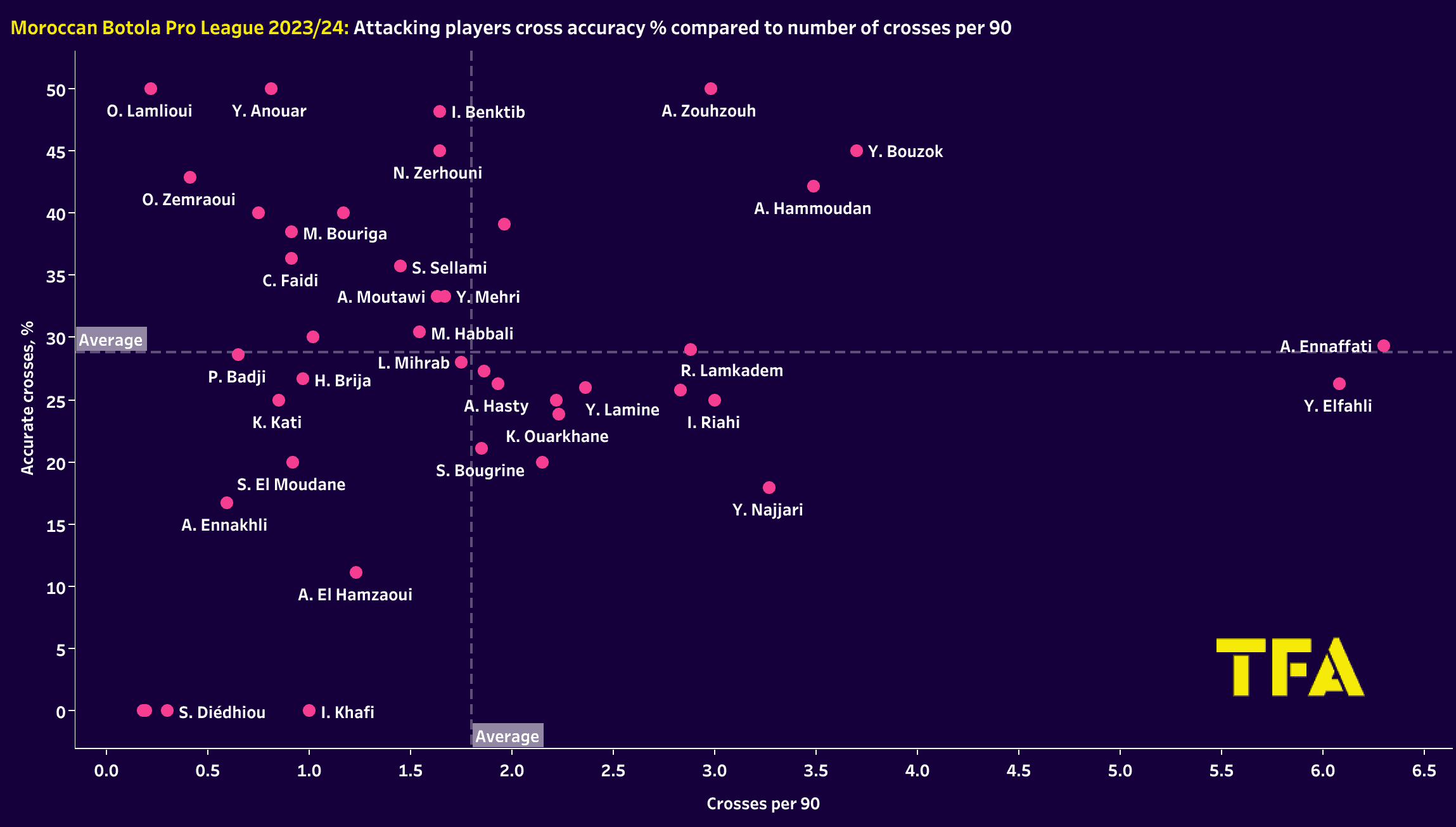
Here, we can see how the players fare in terms of crosses per 90. Of course, in these metrics, we expect the wide players to be leading the way purely due to their positional instructions. Amine Zouhzouh of FAR Rabat averages 2.98 crosses per 90 with a 50% accuracy rating. So, we can infer that half of his crosses reach a teammate. Furthermore, his teammate Ahmed Hammoudan is also performing above average in these metrics, with 3.49 crosses per 90 and a 42.11% accuracy rating.
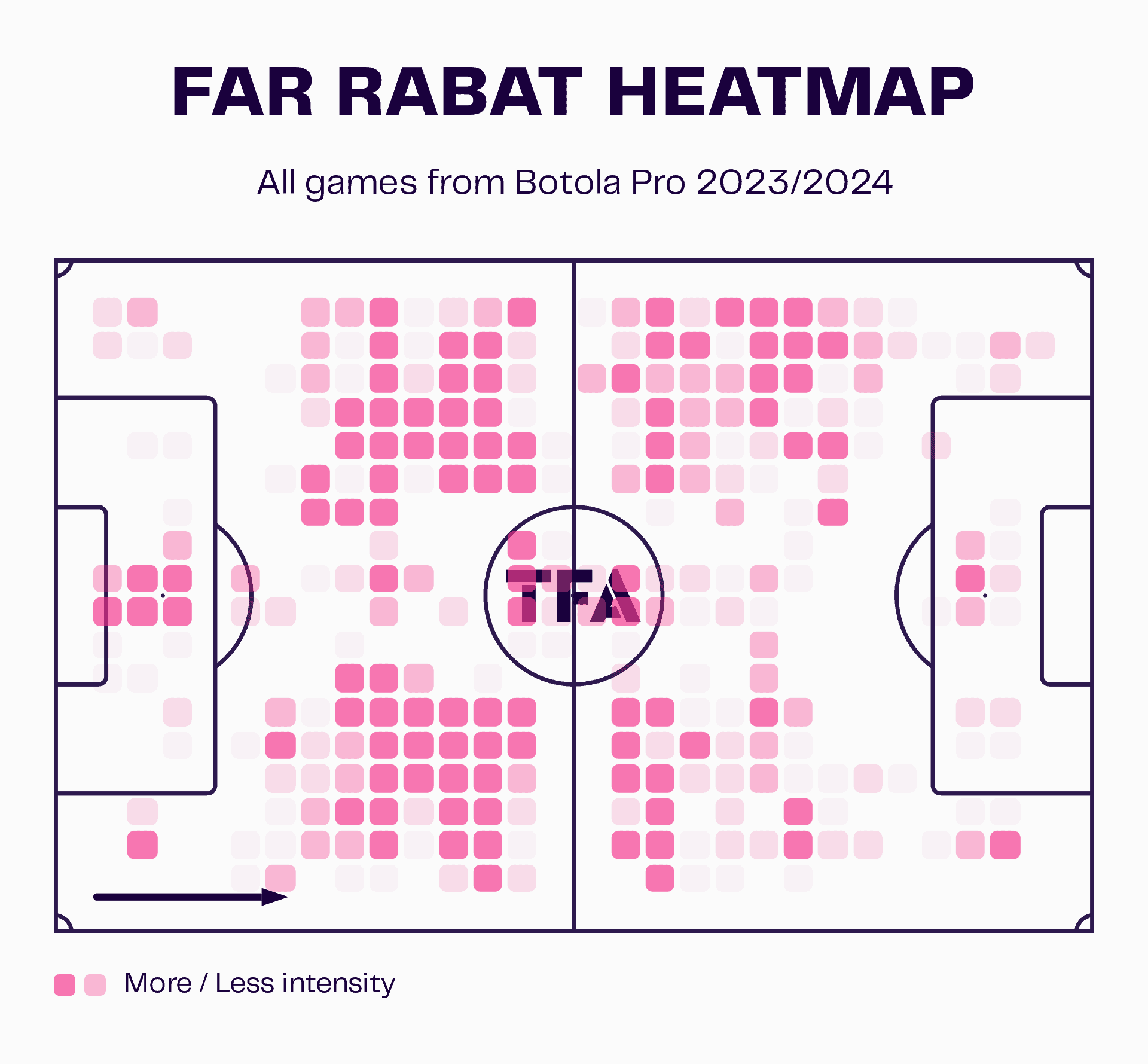
From the heatmap, we can see that FAR Rabat like to focus their play in the wide areas, particularly on the left, which is where Zouhzouh lines up, whilst Ahmed Hammoudan is on the right. Several factors can influence the accuracy of a player’s cross; for example, we have to consider the technical proficiency of the player delivering the cross in addition to the ability of their teammates to find space to receive the cross.
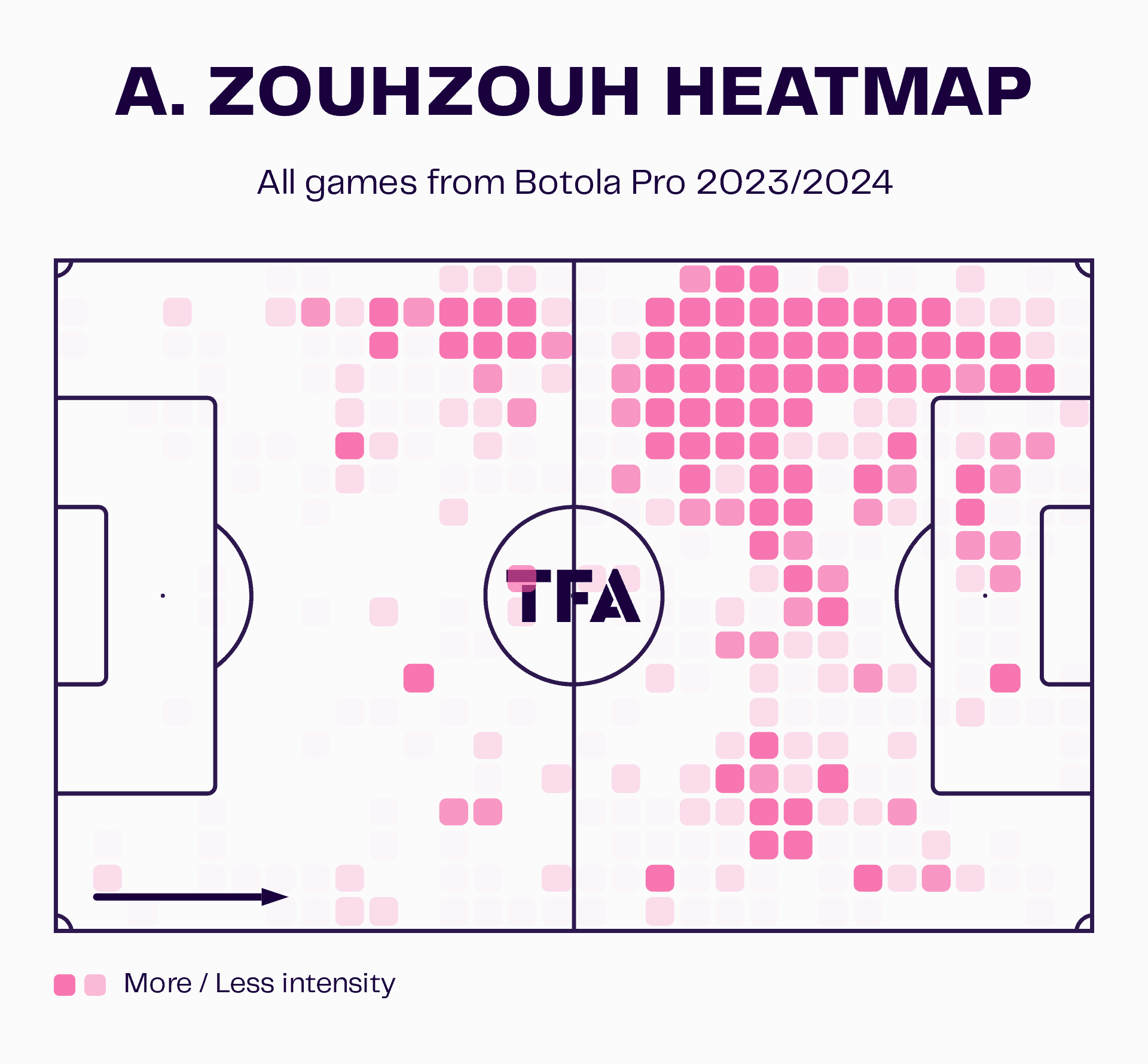
In Zouhzou’s heatmap, we can see that his movement down the left stretches opposing defences, forcing them to defend a larger area. This creates spaces in and around the penalty box, providing opportunities for other attacking players to exploit gaps and make goal-scoring runs. Therefore, his FAR Rabat teammates can alter their movements and positioning accordingly, anticipating his cross into the box.
Additionally, Bouzok averages 3.7 crosses per 90 with a 45% accuracy rating. This fits with Raja Casablanca’s style which emphasises wide play and encourages their wingers to advance into positions often that allow them to play crosses into the box. The 4-2-3-1 system’s structure promotes using the width, especially with Naoufel Zerhouni as the centre forward to aim for in the penalty area.
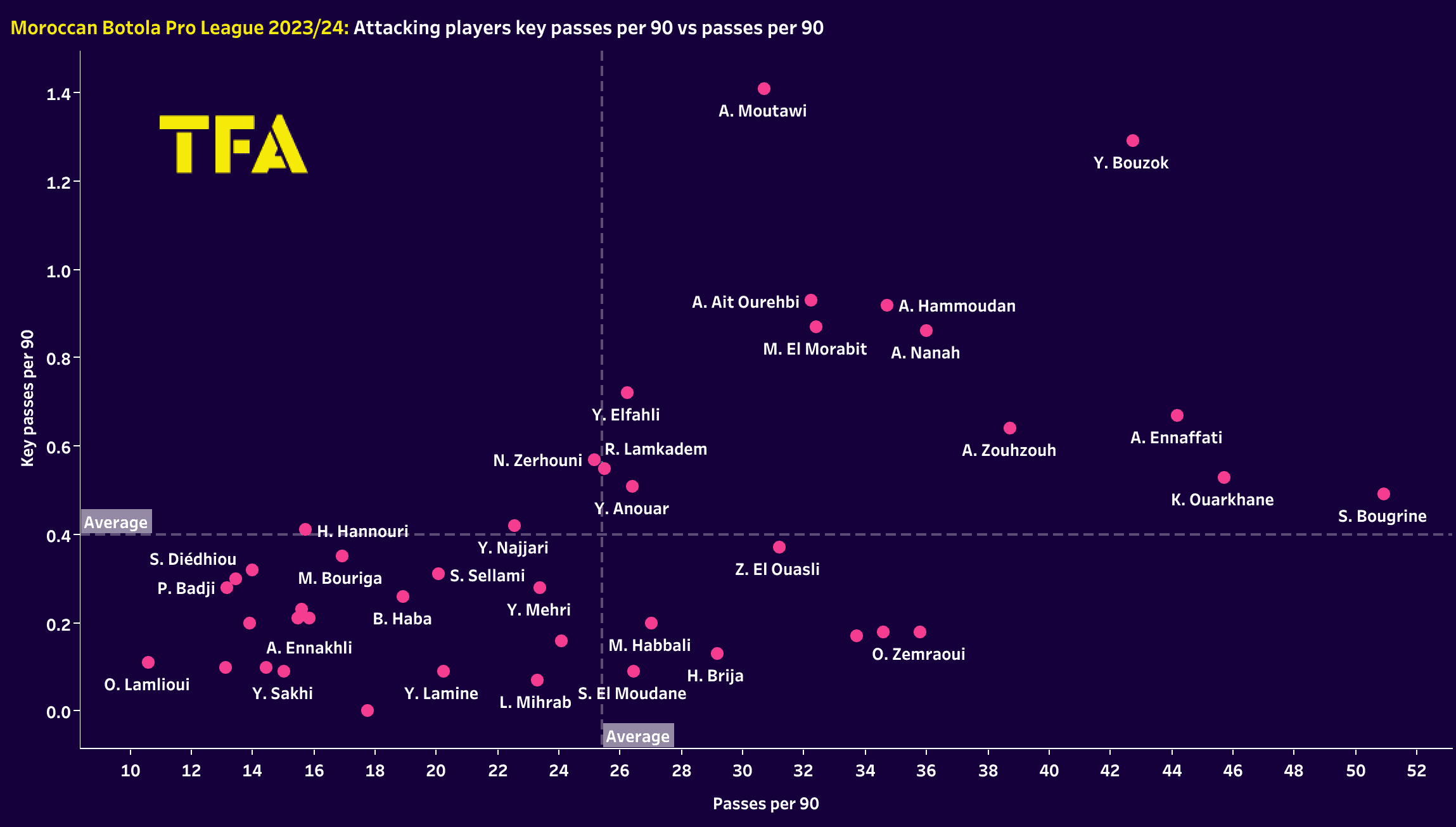
According to Wyscout, a ‘key pass’ is a pass that immediately creates a clear goal-scoring opportunity for a teammate’. This statistical metric is crucial for evaluating a player’s playmaking abilities and impact on the team’s attacking prowess. A key pass is not just any pass but a decisive and incisive delivery that sets up a clear chance for a goal.
When a player makes a key pass, they are essentially unlocking the opposition’s defence with their vision, technique, and understanding of the game. This type of pass intends to breach defensive lines and create a goal-scoring opportunity.
The data visual shows us that Aymen Moutawi averages 30.69 passes per 90 with 1.41 per 90 being classed as key passes. This indicates he is a creative force for RCA Zemamra in terms of creating chances. However, he has only one assist to his name this season, so his key passing is leading to shooting opportunities that are not being converted into goals.
In contrast, Ayoub Nanah of FUS Rabat has chalked up four assists (none from set pieces) with 0.86 key passes per 90. His teammates may be scoring lower percentage chances; therefore, he has more assists to his name than Moutawi.
Ball progression
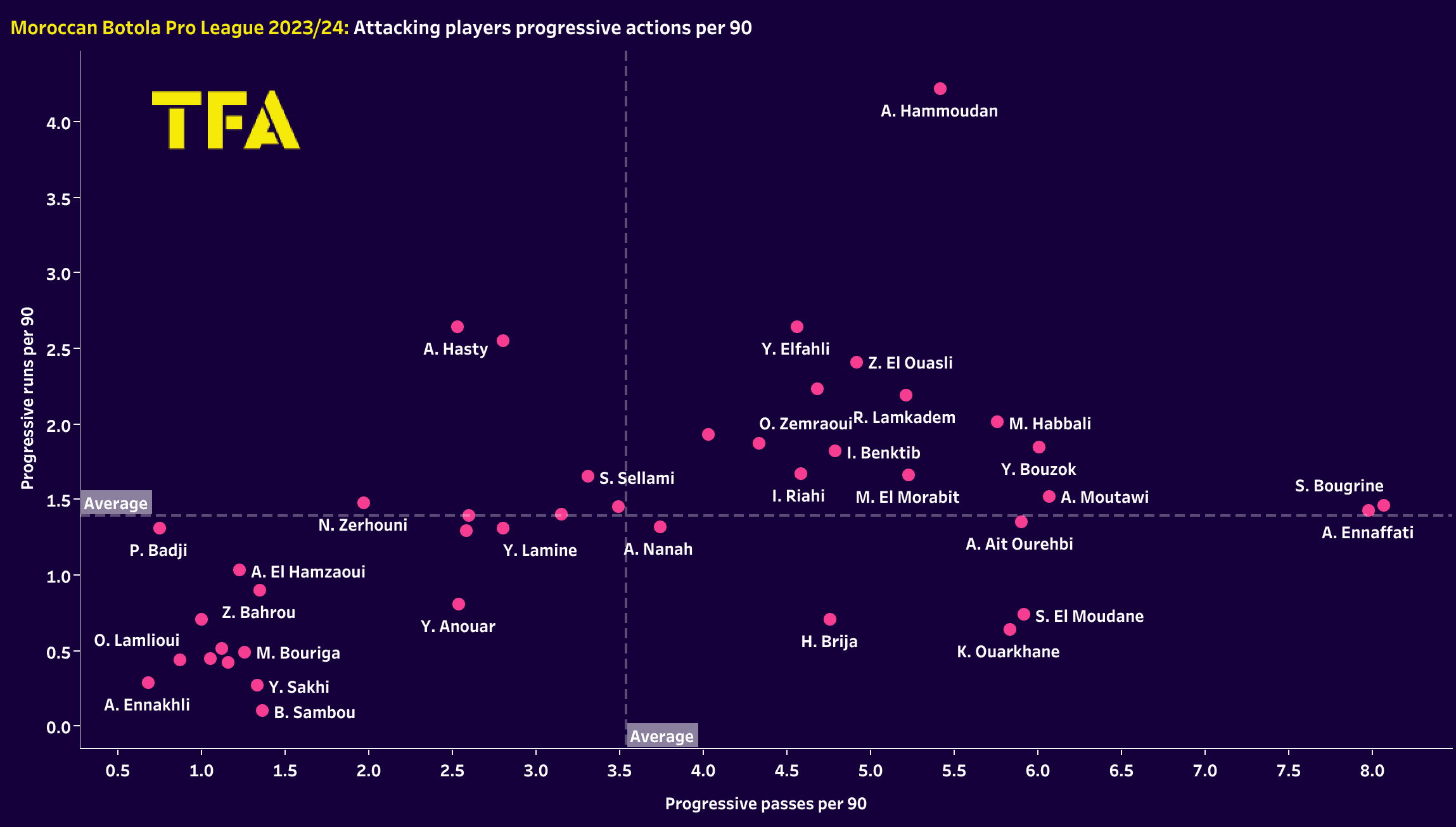
Regarding ball progression, we can see that Ahmed Hammoudan performs exceptionally well. He averages 5.42 progressive passes per 90 and 4.22 progressive runs per 90. This suggests he serves as a critical link between the midfield and the attacking third. By delivering incisive and forward-thinking passes, Hammoudan helps transition the team from defence to attack, exploiting spaces and creating goal-scoring opportunities. His progressive passes can not only break opposition lines but also initiate attacks that catch defenders off guard.
RSB Berkane’s Youssef Elfahli is worth taking note of as he averages 4.56 progressive passes per 90 and 2.64 progressive runs, which places him above average in both metrics. Raja Casablanca’s Sabir Bougrine averages 8.07 progressive passes per 90 and 1.46 progressive runs per 90. His teammate Adam Ennaffati averages 7.98 progressive passes and 1.43 progressive runs per 90.
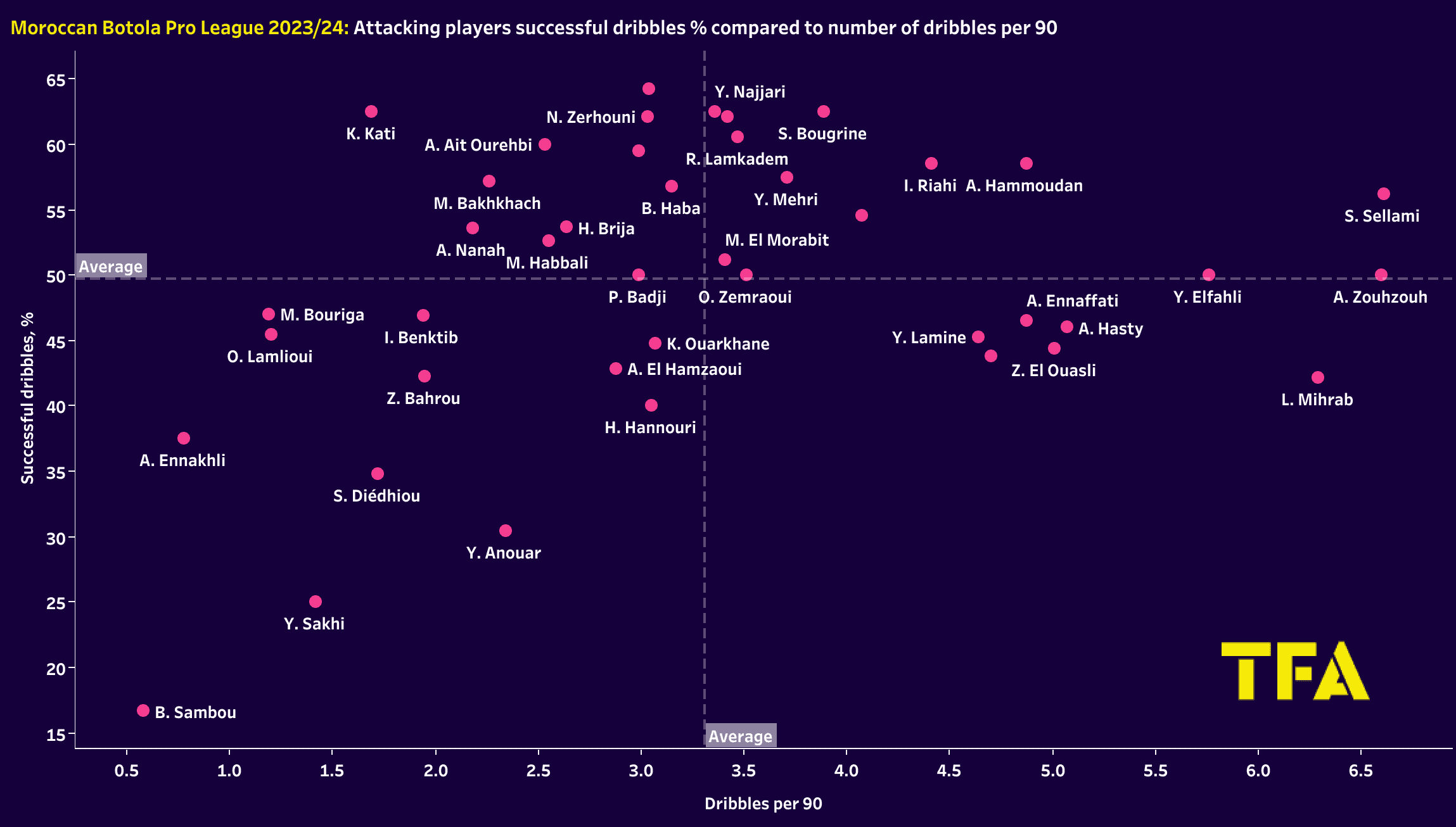
Finally, here we will be analysing the players’ dribbling abilities, which, according to Wyscout, is ‘an attempt to move past an opposing player whilst trying to maintain possession of the ball’.
The data visual shows us that Saleh Essallami of Youssoufia Berrechid likes to use his dribbling abilities frequently, with 6.61 per 90 and a 56.26% success rate. Given that the team are bottom of the league, though, with the fewest goals scored, we can infer that his dribbling rarely leads to potential goalscoring opportunities, especially as he performed below average in terms of key passes per 90.
Moreover, we can see that Ahmed Hammoudan and Amine Zouhzouh perform well in these metrics, indicating they use their dribbling ability to FAR Rabat’s advantage. The former averages 4.87 dribbles per 90 with a 58.49% success rate, whilst the latter averages 6.6 dribbles per 90 with a 50% success rate.
The highest success rating of 64.29% belongs to Aymen Moutawi, who averages 3.03 dribbles per 90, which is below average, so he attempts fewer dribbles but is more successful in the ones he does attempt. This could be down to strategic decisions by the player; he may only opt to attempt to dribble past an opposing player when he sees he has a clear opportunity to beat his man.
Conclusion
In this data analysis, we have analysed the numbers behind the attacking players in Morocco’s Botola Pro League. It is no real surprise that FAR Rabat and Raja Casablanca have the best-performing attacking players, as they currently occupy the top two positions in the league. The play who stood out the most was Yousri Bouzol, the Raja Casablanca man is a very well-rounded winger with an eye for a pass as well as a goal scorer’s instinct.
The data, though, allows us to understand certain aspects of the way the teams look to play and see how these players fit into the tactics. Furthermore, the statistics also allow us to identify individuals who are performing well, such as Aymen Moutawi and Mohamed El Morabit.
With the season at the halfway point, it appears we are in for a two-horse title race, and the attacking prowess of both FAR Rabat and Raja Casablanca will be crucial as they battle for the title.





Comments